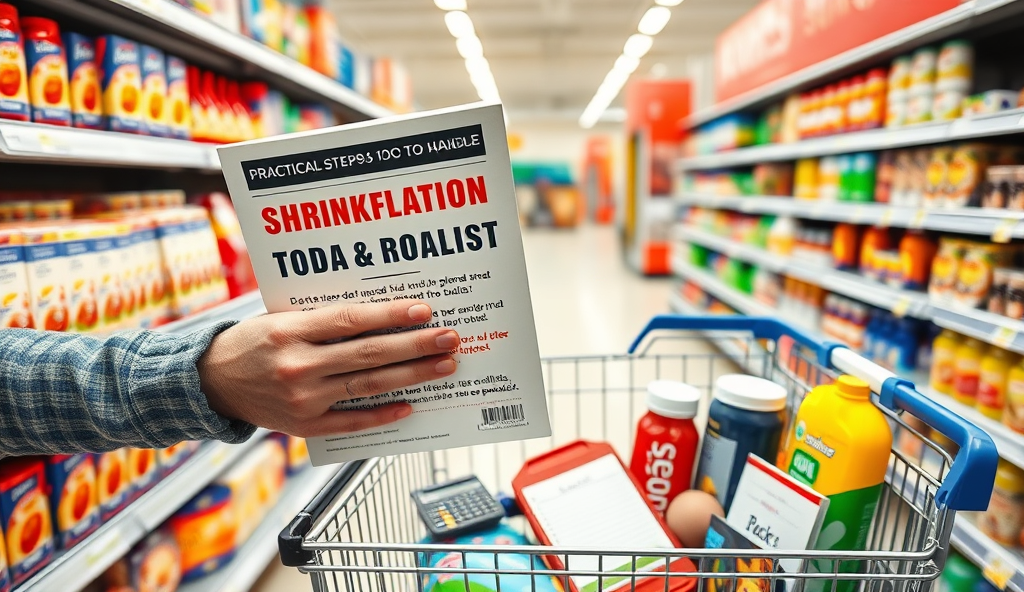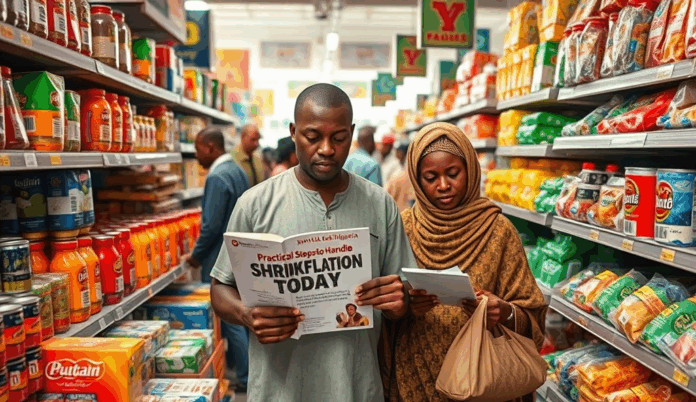Introduction to Inflation and Shrinkflation in Nigeria
Inflation in Nigeria has surged to 28.92% as of December 2023, squeezing household budgets and forcing manufacturers to adopt shrinkflation tactics. Consumers now face rising prices in Nigeria due to inflation while noticing subtle reductions in product sizes, from cereal boxes to detergent sachets.
Shrinkflation effects on Nigerian consumers are evident as brands maintain price points but cut quantities, like when a popular biscuit brand reduced pack counts from 10 to 8. This strategy masks inflationary pressures reducing product quantities, leaving buyers with less value for the same cost.
The Nigerian economy and shrinking product sizes reveal a dual challenge: manufacturers grapple with higher input costs while households struggle with diminished purchasing power. Next, we’ll explore the root causes and broader impacts of inflation on Nigeria’s cost of living crisis.
Key Statistics

Understanding Inflation: Causes and Effects in Nigeria
Inflation in Nigeria has surged to 28.92% as of December 2023 squeezing household budgets and forcing manufacturers to adopt shrinkflation tactics.
Nigeria’s inflation surge to 28.92% stems from multiple factors, including currency depreciation, rising fuel costs, and supply chain disruptions exacerbated by global events. Food inflation, at 33.93% as of December 2023, hits hardest as staples like rice and tomatoes become costlier, deepening the cost of living crisis in Nigeria.
Manufacturers face soaring production costs, with diesel prices doubling since 2022, forcing them to either raise prices or reduce product sizes—a trend evident in shrinking detergent sachets and cereal boxes. These inflationary pressures reducing product quantities disproportionately affect low-income households, whose budgets already stretch thin amid stagnant wages.
The ripple effects extend beyond groceries, as transportation and healthcare costs climb, eroding purchasing power nationwide. Next, we’ll dissect how these economic realities birthed shrinkflation, Nigeria’s stealthy coping mechanism for inflationary strain.
What is Shrinkflation? Definition and Examples
Shrinkflation refers to manufacturers reducing product sizes or quantities while maintaining the same price a subtle tactic to offset rising production costs without alarming consumers.
Shrinkflation refers to manufacturers reducing product sizes or quantities while maintaining the same price, a subtle tactic to offset rising production costs without alarming consumers. In Nigeria, this manifests in downsized detergent sachets dropping from 100g to 80g or cereal boxes losing 20% content despite unchanged packaging.
This strategy disproportionately impacts Nigerian households, as seen when Indomie noodles reduced pack counts from 100 to 90 pieces or Peak Milk tins shrank from 400g to 360g. These stealthy reductions compound Nigeria’s cost of living crisis, where consumers pay more for less amid 33.93% food inflation.
While shrinkflation helps manufacturers survive diesel price hikes and currency depreciation, it erodes purchasing power silently. Next, we’ll explore how Nigeria’s inflationary pressures directly fuel this packaging deception.
The Link Between Inflation and Shrinkflation in Nigeria
Nigeria’s 33.93% food inflation directly fuels shrinkflation as manufacturers face soaring input costs from diesel price hikes (now ₦1200/liter) and naira depreciation (₦1500/$).
Nigeria’s 33.93% food inflation directly fuels shrinkflation, as manufacturers face soaring input costs from diesel price hikes (now ₦1,200/liter) and naira depreciation (₦1,500/$). For instance, Nestlé Nigeria’s 2023 report revealed a 40% production cost surge, prompting Milo tin reductions from 900g to 800g while retaining ₦3,500 price tags.
Currency instability exacerbates the trend, with imported raw materials becoming 60% costlier since 2022, forcing brands like Dangote Sugar to shrink 50kg bags to 45kg. This mirrors Central Bank data showing manufacturing sector inflation hitting 22.4% in Q1 2024, pushing firms toward stealthy quantity cuts rather than visible price hikes.
As inflationary pressures persist, shrinkflation becomes a survival tactic for businesses, though it transfers economic strain to consumers. Next, we’ll examine how these shrinking packages specifically impact Nigerian households’ budgets and consumption patterns.
How Nigerian Consumers Are Affected by Shrinkflation
Nigerian households now pay the same prices for 10-20% less product with National Bureau of Statistics data showing average families spend 56% of income on food up from 42% in 2020.
Nigerian households now pay the same prices for 10-20% less product, with National Bureau of Statistics data showing average families spend 56% of income on food, up from 42% in 2020. This hidden inflation forces consumers to either accept reduced quantities or stretch budgets further, as seen when a ₦5,000 weekly grocery haul now contains 15% fewer items than in 2022.
The psychological impact compounds financial strain, with 68% of Lagos shoppers reporting frustration upon discovering smaller packages during purchases, according to a 2023 Consumer Rights Commission survey. Brands maintain shelf prices while quietly reducing content, leaving buyers with less nutritional value per naira spent—particularly damaging for staples like rice and milk.
These shrinkflation tactics disproportionately affect low-income earners, who spend 73% of earnings on essentials compared to middle-class Nigerians’ 52%, per World Bank Nigeria poverty assessments. Next, we’ll identify which everyday products face the most severe quantity reductions across Nigerian markets.
Common Products Experiencing Shrinkflation in Nigeria
To combat shrinkflation’s impact on staples like rice and milk Nigerian consumers can prioritize bulk purchases from local markets where 10kg rice bags often offer better value than downsized 450g packs.
Staple foods like rice, wheat flour, and vegetable oil lead Nigeria’s shrinkflation crisis, with 500g rice packs now containing 450g while retaining 2022 prices, according to a 2023 NAFDAC market survey. Milk producers have reduced sachet sizes from 50g to 40g, forcing families to buy more units for the same nutritional value—a tactic costing low-income households an extra ₦1,200 monthly.
Snack brands like biscuits and noodles now offer 10-15% fewer pieces per pack, with Consumer Protection Council reports showing 70g biscuit packs shrinking to 60g despite stable retail prices. Even hygiene products like soap bars and detergent sachets have seen weight reductions, squeezing budgets further as Nigerians pay more for less across essential categories.
The next section explores practical strategies to counter these shrinkflation effects, helping consumers stretch their naira further amid Nigeria’s rising cost of living.
Strategies for Nigerian Consumers to Cope with Shrinkflation
To combat shrinkflation’s impact on staples like rice and milk, Nigerian consumers can prioritize bulk purchases from local markets, where 10kg rice bags often offer better value than downsized 450g packs. Comparing unit prices (e.g., ₦ per gram) across brands helps identify hidden cost hikes, as seen with biscuits shrinking from 70g to 60g despite unchanged shelf prices.
Switching to unbranded alternatives or generic products—like open-market detergent bars instead of shrunken sachets—can save households up to 20% monthly, according to a 2023 Lagos consumer group study. Meal planning and reducing snack purchases compensate for noodle packs with 15% fewer portions, aligning budgets with Nigeria’s rising cost of living.
Tracking product sizes through receipt documentation exposes gradual shrinkflation, empowering consumers to report violations to regulators—a transition to discussing government responses next. Collective bargaining through cooperatives also pressures manufacturers to maintain transparency amid inflationary pressures.
Government and Regulatory Responses to Shrinkflation in Nigeria
The Federal Competition and Consumer Protection Commission (FCCPC) has intensified market surveillance, fining three major food brands ₦500 million in 2023 for deceptive packaging practices. New labeling regulations now mandate clear quantity disclosures alongside prices, addressing the biscuit downsizing from 70g to 60g highlighted earlier.
State governments like Lagos have launched consumer protection units to investigate shrinkflation complaints, leveraging the receipt documentation strategy discussed previously. These units processed over 1,200 cases in Q1 2024, with 40% resulting in product restitutions or manufacturer penalties.
While these measures show progress, persistent inflationary pressures require stronger enforcement of existing laws and standardized packaging audits. This regulatory landscape sets the stage for concluding our examination of Nigeria’s shrinkflation challenges and solutions.
Conclusion: Navigating Inflation and Shrinkflation in Nigeria
As Nigeria’s inflation rate hits 28.92% (NBS, 2023), consumers must stay vigilant against shrinkflation tactics like reduced biscuit packs or smaller detergent sachets. Comparing unit prices and opting for bulk purchases can help mitigate the impact of rising prices in Nigeria due to inflation while maintaining household budgets.
Manufacturers are increasingly adopting shrinkflation tactics to cope with production costs, but consumer awareness is key to making informed choices. Nigerian households facing shrinkflation should prioritize essential goods and explore local alternatives where possible to stretch their naira further.
While inflationary pressures reducing product quantities may persist, strategic shopping and budget adjustments can help Nigerians navigate this cost of living crisis. Staying informed about market trends empowers consumers to spot shrinkflation effects on Nigerian consumers and adapt their purchasing habits accordingly.
Frequently Asked Questions
How can I spot shrinkflation when shopping for groceries in Nigeria?
Always check the net weight or quantity on product labels and compare them to previous purchases—keep a shopping journal to track changes over time.
What are the best alternatives to branded products affected by shrinkflation?
Opt for unbranded staples like open-market rice or detergent bars which often offer better value than downsized packaged goods.
How can I calculate the real price increase caused by shrinkflation?
Divide the product price by its weight (e.g., ₦500/100g) to get unit cost—compare this across brands and over time to detect hidden hikes.
Where should I report suspected shrinkflation cases in Nigeria?
Document evidence and file complaints with the FCCPC via their mobile app or hotline (07002255272) for investigation.
What bulk-buying strategies work best against shrinkflation for Nigerian households?
Form cooperatives with neighbors to purchase 25kg rice bags or gallon-sized oils directly from distributors—splitting costs and quantities fairly.


